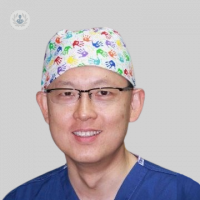What can I do to help my child with glue ear?
Written by:When it comes to deciding on a treatment plan for your child if they have glue ear, you first need to establish that the child actually has the condition and that it is 'sticking around', so to speak.
If hearing loss persists for more than six to eight weeks you should seek medical advice to ensure that glue ear is the correct diagnosis. Sometimes in younger children, hearing loss manifests itself as speech delay or behavioural changes.
If the hearing loss on audiometry is significant, or there are chronic changes in the eardrum, it is then that you would need a specialist investigation and intervention. Other symptoms of middle ear disease, however, such as high temperature, earache or ear discharge require more urgent attention.
Here, paediatric ENT specialist Mr Michael Kuo explains the options available when it comes to treating a case of glue ear that isn’t clearing up by itself.

What are the treatment options for glue ear?
The treatment plan will be discussed with your specialist but these are the treatment options for glue ear, depending on the individual case:
Option 1 – Watchful waiting
In favour of pursuing a period of watchful waiting is that the glue ear may still resolve on its own, but against it is that while waiting for it to resolve, your child will continue to have difficulty hearing.
Option 2 – A matter of aiding
Hearing aiding can be achieved broadly by two methods, amplification and redirection.
Amplification is effectively the use of audiological “brute force,” which means your child wears a hearing aid that simply amplifies sound and is not unlike a hearing aid that more elderly people wear when they have age-associated hearing loss.
Redirection is aiding by “stealth”; that is to say sending sound to the inner ear but by-passing the middle ear, which is where the glue is causing the problem. This can be done using a variety of headbands and bone conduction hearing aids.
The advantage of aiding is that there is no physical intervention, but against it is that it is highly dependent on both child and parental compliance. A hearing aid only works if it is being worn. There is a temptation that as soon as the child goes around the corner into school that they take it off because the hearing aid is probably not considered the height of fashion.
Option 3 - Mechanically ventilating the middle ear
This requires a degree of cooperation and compliance by the child and, therefore, requires the child to be perhaps at least six years of age. We know when we fly that our ears can get blocked up. This is similar to the situation in glue ear and we can unblock our ears by pinching our nose, closing our mouths and breathing out. This causes a “popping” of the ears and restoration of normal middle pressure and hearing.
This is called the Valsalva manoeuvre but children often do not like to do it because they feel as if their eyes are popping out before the ears pop! There are devices which help children to do the same manoeuvre more gently, which are available over the counter, e.g. Otovent or Ear Popper.
Option 4 - Surgery
Finally, there are surgical options available for the treatment of glue ear.
The first option involves the insertion of a ventilation tube into the eardrum, which allows air to enter the middle ear without going through the Eustachian tube. This is what is commonly known as a “grommet”. This is carried out under a brief general anaesthetic.
In favour of this is that the child’s hearing improves almost immediately and there is no cooperation of the child involved. There are, however, risks of surgery, albeit small. This includes the risk of a discharging ear during the lifetime of the grommet, which can be managed with antibiotic eardrops, and long-term perforation of the eardrum, which may happen in one in a hundred children. The ventilation tubes generally fall out of their own accord around nine to eighteen months after they are put in.
Alternatively, insertion of ventilation tubes can be combined with the removal of the adenoids (a patch of tissue that sits at the back of the naval cavity) at the same time. In favour of this is that there is evidence showing that removing the adenoids decreases the chance of recurrent glue ear after the grommets fall out. It addresses the primary problem of adenoidal hypertrophy. The downside is that it is a considerably bigger operation than just having ventilation tubes put in.
Read more on the signs of glue ear
Do not hesitate to book an appointment with Mr Kuo if you’re concerned that your child needs a check-up.


